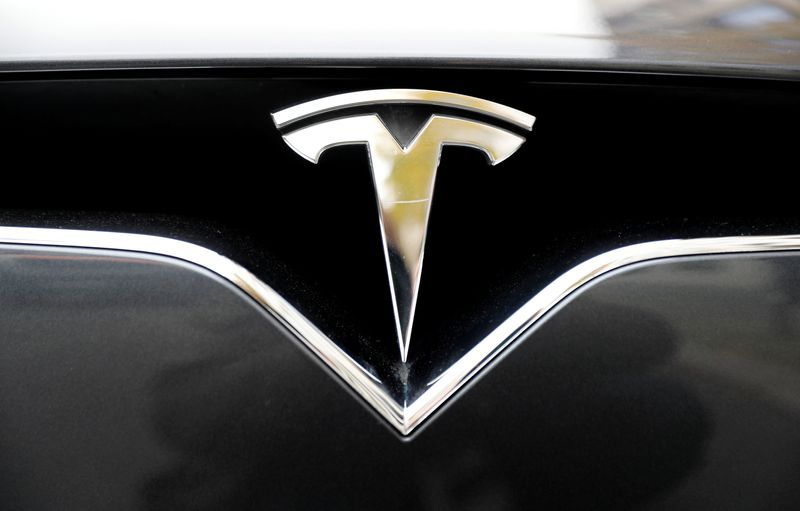Historical stock market volume is likely to this week as addition of Tesla into the S&P 500

FILE PHOTO: The company logo is pictured on a Tesla Model X electric car in Berlin, Germany, November 13, 2019. REUTERS/Fabrizio Bensch
The addition of Tesla into the S&P 500 at the nearby this Friday will be one of the greatest exchanging days history, yet it is just the latest illustration of a progressing trend: index managers who settle on the choices of what goes all through these lists are getting progressively compelling.
“Rebalancings have become major trading events because more investors are tied to indexes, so the volume of trading during rebalances has gone way up,” Harry Whitton from market maker Old Mission told me.
Whitton noticed that the heaviest long periods of exchanging are currently commonly on significant list rebalancings. The S&P 500 will rebalance on Friday, one of four days every year it does as such. Friday’s rebalance will probably observe record levels of exchanging action at the nearby because of Tesla’s expansion to the S&P 500.
Notwithstanding the S&P rebalancing, a few significant ETFs will likewise rebalance on Friday, including the Invesco QQQ Trust (QQQ), which is recorded to the intensely hot NASDAQ 100, and the Renaissance Capital IPO ETF (IPO), which has been on a tear because of the surge of late IPOs and as of late hit $700 million in resources under administration.
What happens when indexes rebalance
Rebalancings typically include changes in the weighting of the organizations recorded in the lists, however it can likewise include augmentations or cancellations to the files (known as “reconstitution”). Common assets, ETFs, and other people who try to impersonate the conduct of the file should then purchase or offer the stocks with respect to their weightings in the files.
Indexes should be rebalanced and reconstituted on the grounds that a few organizations not, at this point fit with the principles or rules of the file. Others that are not in the index will meet the standards for consideration.
Some rebalancing is done semiannually, quarterly, or even month to month. Some lists rebalance across the board day, while some spread the exchanging out more than a few days.
On account of the S&P 500, the rebalancing is completed four times each year. On account of the Russell 1000 and Russell 2000, the rebalancing is done once every year.
Choosing what goes into a record is a convoluted undertaking. Some utilization “mechanical” techniques that consequently placed stocks in the record in the event that they meet certain models. The Russell 1000, for instance, will just remember the 1,000 biggest stocks for the United States. The S&P 500, then again, is picked by an advisory group that looks to remember the biggest organizations for the United States. Those that are incorporated are weighted by market capitalization.
Index rebalancing has become significant in light of the fact that such a lot of cash is presently attached to these files. Take the instance of the SPDR S&P 500 (SPY), the biggest ETF on the planet, with over $320 billion in resources under administration. This ETF looks to follow the exhibition of the S&P 500. The ETF backer (for this situation, State Street Global Advisors, which works SPDR), licenses the S&P 500 record from S&P Dow Jones Indices. At the point when the index is rebalanced, the backer (for this situation, S&P Dow Jones Indices) tells the guarantor (for this situation, State Street) what changes are being made. The guarantor than needs to choose what to purchase or sell, and how to do the exchange. That exchange brings about critical measures of exchanging action.
Nasdaq 100 rebalancing: Tech progressing
The Nasdaq 100 Index comprises of the 100 biggest non-monetary organizations recorded on Nasdaq and is the premise of the Invesco QQQ Trust ETF (QQQ). It rebalances four times each year yet organizations are added or erased to the file (“reconstitution”) just once every year. That reconstitution will happen on Friday after the nearby. Throughout the end of the week, Nasdaq reported that six organizations would be added to the record, and six erased.
The six organizations going in are: American Electric Power Company (AEP), Marvell Technology Group (MRVL), Match Group (MTCH), (OKTA), Peloton Interactive (PTON), and Atlassian Corporation (TEAM).
The six being eliminated are: BioMarin Pharmaceutical (BMRN), Citrix Systems (CTXS), Expedia Group ( EXPE), Liberty Global (LBTYA/LBTYK), Take-Two Interactive Software (TTWO), and Ulta Beauty (ULTA).
Speculators who are benchmarked to the Nasdaq 100 should purchase those stocks being added and sell those being erased. As inactive putting has filled in impact, the totals contributed — and the measure of exchanging that happens around the rebalancing — has developed extensively.
The Invesco QQQ Trust (QQQ) is the fifth biggest ETF in the U.S., with generally $150 billion in resources under administration. The Nasdaq 100 Index is likewise a benchmark for a huge swath of extra monetary items, for example, alternatives and prospects.
Tesla will be the greatest rebalance in history
In light of its size, indexers attached to the S&P 500 are relied upon to purchase generally $80 billion worth of Tesla to remember it for the S&P 500, which implies backers should sell $80 billion of the leftover stocks in the S&P 500. This by itself would be by a wide margin biggest rebalancing in S&P’s set of experiences: The earlier record of $50.8 billion was in September of 2018. Tesla will probably be generally 1% of the S&P 500′s market capitalization after its consideration.
Rebalancing: A cat and mouse game
The entirety of this exchanging — and cash — sets up a problematic round of feline and-mouse between the individuals who need to purchase and sell stock (the individuals who are attached to the lists like ETFs and common assets) and the individuals who can purchase from or offer to them (the business network).
“The goal of indexers is to buy Tesla at the close next Friday, and to sell the other companies at the close,” Howard Silverblatt, Senior Index Analyst at S&P Dow Jones Indices, told me.
This, Silverblatt says, puts indexers at chances with the exchanging network: “If you are a trader or an investor, your goal is to buy or sell to the indexers at a profit.” To ensure they will have the correct equilibrium of stocks, backers frequently will wind up settling on concurrences with business houses to convey the stock they need to purchase or sell on the exchange date.
“The indexers pay a fee to the trading community to ensure they can get at least a portion of the stock they need,” Silverblatt noted. “It’s all part of the cost of doing business.”
Heaps of arranging, however nobody realizes what will occur
On a crucial premise, this torrent of exchanging ought not change costs, since there is no adjustment occupied with the organizations recorded. In any case, there are huge changes in organic market achieved by list consideration or rejection, and that can and impacts costs.
What’s more, that is the thing that makes these occasions a piece harrowing, especially when you are managing something as large as Tesla, and somewhat unsure.
“Truly, we don’t actually have the foggiest idea what will occur,” Silverblatt let me know.
Index managers are the new global asset managers
Ben Johnson, head of worldwide ETF Research for Morningstar, says the key takeaway is that in the past dark file suppliers are currently significant parts in figuring out who claims what in the contributing scene.
“These index providers are much more than just index providers–they are effectively portfolio managers,” Johnson told me. “They’re not asset managers, but they are determining where the money is going through their decisions about who goes into and out of these indexes.”
Thus, the index committees for the significant suppliers — regardless of whether they are for S&P, NASDAQ, FTSE, or MSCI — have gotten amazingly compelling: “These index committees have become one of the largest discretionary asset managers on the planet,” Johnson let me know.
About Author
Disclaimer: The views, suggestions, and opinions expressed here are the sole responsibility of the experts. No Feature Georgia Heralds was involved in the writing and production of this article.






